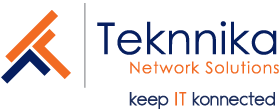The Most Common Cybersecurity Risks
With so much of our business and personal lives dependent on our devices, keeping that information safe is important. The number of cybercrime events has risen each year, so it’s more important than ever to know what cybersecurity risks look like and how you can keep your information safe. Teknnika Network Solutions offers a variety of services to keep your devices, networks and information safe from cyber-attacks.
Smart devices
Smart devices can range from mobile phones to smart homes, meaning they could hold a wealth of personal information or even unlock your front door. Most smart devices don’t have cybersecurity software downloaded on them, leaving them vulnerable to attacks. One easy way to prevent your smart devices from becoming an entry into the rest of your system to is to have them connected to your guest Wi-Fi rather than your private personal network. Having them on separate networks acts as a second line of defense against hackers who have hit one network or the other. Of course, this set-up should not replace actual cybersecurity software.
Denial-of-Service
Denial-of-service attacks (commonly called DoS) occur when the server is flooded all at once so that the system cannot perform legitimate tasks. Multiple devices may be used in such an attack, which is known as a distributed-denial-of-service (DDoS) attack.
Botnets
A botnet (“robot network”) is a group of devices connected to the internet which have had their security breached and are controlled by a third party. Some devices may be operating as “zombies” – that is, the owner of the device is unaware that their device is being used in such a group. Such devices can be used to launch attacks such as DDoS or the spreading of malicious messages.
Phishing
We’ve all heard of phishing calls – criminals posing as legitimate businesses attempting to get personal information from an unsuspecting person – but phishing also occurs online through messaging services and emails. Beware of giving out sensitive information or clicking on suspicious links, especially if you weren’t expecting any of the sort.
Malware
Malware, or “malicious software,” is often spread through dangerous links or email attachments. Malware can harm systems on your computer and/or install spyware, which covertly steals information, or ransomware.
Ransomware
Ransomware is a form of malware which holds aspects of a system “hostage.” The ransomware installer will usually say that they will only free your system or data in return for a sum of money. However, there is never any guarantee that the ransom-holder will return anything after receiving the ransom. One way to protect yourself and your organization against ransomware is to perform frequent backups of your computers. That way, you can retain access to your files and restore them from a backup.
Man-in-the-Middle Attack
In a man-in-the-middle attack, the attacker inserts himself into a line of communication like that between a user and an unsecure Wi-Fi network. In such an attack, the user unknowingly transfers all information through the attacker. This point-of-entry can easily be avoided by using only secure Wi-Fi networks.
At Teknnika, we provide managed IT services, network and data security solutions, business documentation and disaster recovery to protect your networks against threats. Call us at (954) 667-9481 to see how we can help protect your data!



Social